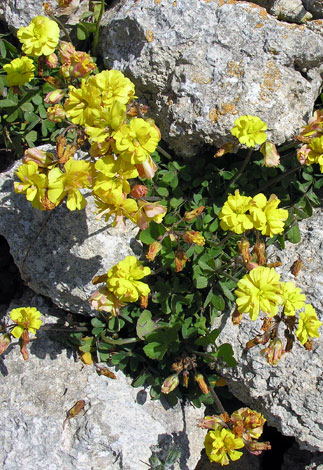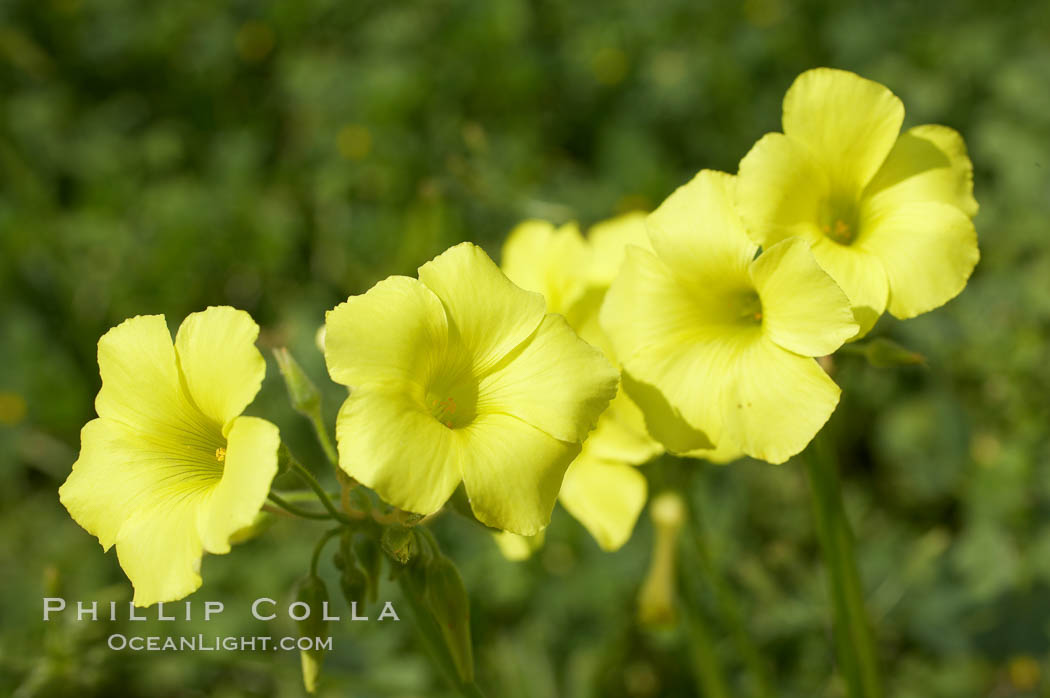

This species most commonly reproduces via underground bulbs and bulbils (seeds are rarely produced in Australia). The short capsules are rarely formed in Australia. Flowering occurs mainly from early winter through to late spring (i.e. They open only during sunny conditions and close again at night or during dull conditions. These flowers also have five sepals, ten stamens and an ovary topped with five styles. tubular) in appearance with five broad overlapping petals (15-25 mm long) that are fused together towards their bases. The bright yellow flowers (25-40 mm across) are borne in loose clusters (each with 3-25 flowers) at the top of the stems on individual stalks (i.e. They are hairless with entire margins and deeply-notched tips (i.e. These leaflets (5-30 mm long and 4-35 mm wide) are mostly green in colour, sometimes bearing brown or purple-coloured markings, and fold downwards during darkness. petioles) 5-22 cm long and consist of three heart-shaped (i.e. rhizome) at or just below the soil surface. The leaves emerge from the top of an underground stem (i.e. However, while they both can have a similar appearance with trifoliate sectioned leaves, oxalis is easily distinguishable by having heart-shaped leaves compared to the oval-shaped leaves of clover.

Secateurs, Pruners, Saws & Garden ToolsĪn almost hairless plant with long-stalked, trifoliate leaves that often have dark spots.Growing Media, Soil Amendments & Conditioners.Growing Media, Components & Conditioners.The Nature Conservancy Global Invasive Species Team. Bright yellow flowers occur in drooping clusters on top of a single leafless stalk. Clover-like, bright green leaves, often with purplish brown speckles or markings on the upper surface. Brief description: a small, succulent plant growing up to 40 cm high.

Soil Solarization for Gardens and Landscapes. soursob, Bermuda buttercup, yellow flowered oxalis, African wood sorrel. Poisonous Plants of the United States and Canada. Factors affecting germination in greenhouse-produced seeds of Oxalis corniculata, a perennial weed. Weeds of California and Other Western States. The plant dies in the summer months.ĭiTomaso, J. The Bermuda Buttercup develops in the late winter and early spring. White bublets sometimes develop on the stem, and cultivates adjacently to an aboveground plant. Also, sometimes the three leaflets are spotted with purple dots. The Bermuda Buttercup grows from bulbs that come about in the fall months. With this shamrock like plant, there can only by three sides and on a rare occasion four. The average height for this plant is 14 inches and rarely goes beyond that. This flower blooms in between November and April. Death is a common result and many farmers like to kill of the Bermuda Buttercup from their farming ground. Oxalate poisoning is common for livestock to receive if there is a high consumption.

"The genus name Oxalis is derived from the Greek word meaning “sour,” referring to the sour-tasting oxalic acid present throughout the plants." (DiTomaso 2007). This is a significant family, because it is very poisonous to those who intake the two plants too much. The Bermuda Buttercup is related to Oxalis corniculata ( blossom_top(aka).jpg). It is also used commonly as a plant for landscape architectures. The common ecology of a plant like this is found mostly in irrigated territories, vineyards, crop fields and urban areas. Interesting to know how it ended up in Berkeley. The Bermuda Buttercup is also a South African native, cultivated as a ornamental. It is a common weed in artichoke fields in Central CA. This shamrock like plant is a "a low growing perennial broadleaf plant" (Davis 2014) most commonly found in CA. Named the "Bermuda Buttercup" is also known as buttercup oxalis. Give your lawn at least one application of a good quality fertiliser per year. If it’s really bad, hollow tine in the autumn. Spike your lawn every spring and autumn to relieve soil compaction. I immediately snapped the photo, because it's origins were something I was curious about. Scarify your lawn every couple of years to remove excess moss and thatch (usually in the autumn). Yellow on a gray day, it stuck out to me. I was walking on Bancroft when I saw this plant. Natural History Story of the Bermuda Buttercup


 0 kommentar(er)
0 kommentar(er)
